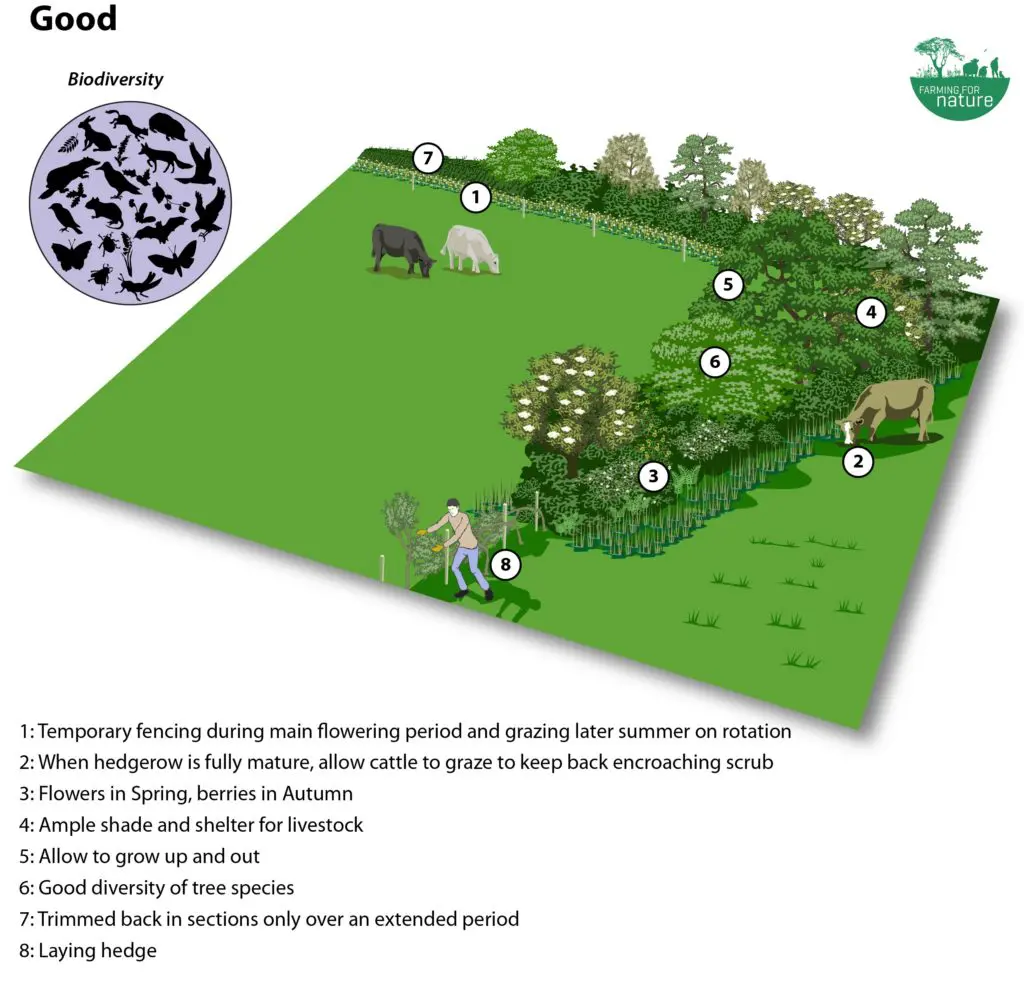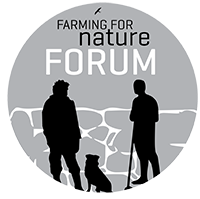Field boundaries
Field boundaries are a common feature of the Irish countryside. Those of value to wildlife include:
1. Hedgerows
2. Stone walls
3. Fences
4. Watercourses
Field boundaries are key areas for nature, providing food, water, shelter, nesting sites and essential corridors for movement of wildlife between otherwise isolated habitats. They are home to a variety of wildlife, including birds, small mammals and many insect species. For the farmer, field boundaries can provide shelter and shade for livestock, prevent soil erosion, and can help to reduce pollution from agricultural run-off or spray-drift. There are a variety of actions farmers can take to improve the quality of their field boundaries for nature.
Actions on the Farm
The first step to improving the value of your field boundaries is to have a look at their current condition and see what wildlife they currently support. Take some time to record the plant and animal species in your field boundaries; this will help you to identify which areas are the best and worst for biodiversity and to plan for improvements.
Once you have a good understanding of the condition of your field boundaries, dip into our tips below to learn how to enhance hedgerows, stone walls, fences and watercourses on your farm!
1. HEDGEROWS:
REPAIRING DAMAGED HEDGEROWS
- Gaps or ‘leggy’ hedgerows are less beneficial to wildlife and offer reduced shelter for livestock. Planting any gaps with native flowering hedgerow species will increase available habitat for wildlife and provide food for important species such as pollinators.
- Fill gaps in hedges with native – and preferably local – species to increase the hedgerow’s value for nature. You can do this by laying, coppicing or planting up the gaps and improving the leggy areas. Lightly trample vegetation around young saplings until they get established (for the first 4-5 years) so that other vegetation doesn’t block out the light and prevent them from growing.
- Laying is the best method of rejuvenating gappy or damaged hedgerows as the hedge continues to flower, providing food for wildlife. This involves cutting the stems part of the way through, bending them over and interweaving them.
- Another option is coppicing – this involves cutting the stems all of the way through to encourage new growth at the base. However, coppiced hedgerows may take years before flowering again, temporarily reducing their benefits to wildlife. Both methods should be done in short sections rather than long ones as both take some time to provide habitat for birds and insects.
MANAGING HEDGEROWS
- Ideally hedgerows should be left to grow and expand as much as possible but this is not always possible on a farm and sometimes they have to be managed.
- Avoid cutting everything at once: cut on a 3–5-year rotation so that there is always a section of uncut hedgerow left for wildlife. Ideally, only cut a short section of the hedgerow in any one year as this allows flowers and berries to grow on the older trees.
- In a 3-year rotation cut only a third of your hedgerows each winter. If the fields either side of a hedgerow are under the same management, consider cutting one side this year, and the other side the next.
- Aim to shape your hedgerow into a roughly triangular ‘A-shaped’ profile, with a wide base. The broad base and narrow top allow light in at the base, which encourages dense growth at ground level. However, as before, do consider leaving one side uncut altogether to encourage growth.
- Take care to avoid cutting mature trees or saplings that will become your future hedgerow trees. These trees form important canopy habitat and song posts for birds.
- For a low, dense, stock-proof hedge, cut plants like blackthorn and hawthorn low to the ground after planting and continue to cut back each year to encourage dense growth at the base.
- Take time to observe as ‘one size doesn’t fit all’ – for instance if you have a row of one species, such as sycamore or ash, which can be gappy at the base but have a dense canopy, consider cutting in places to allow more light in and to encourage more diverse growth at the base.
- Under the Irish Wildlife (Amendment) Act 2000, it is important to note that no hedge cutting can be carried out between the 1st of March and the 31st of August. However, if you can delay trimming as late as possible (i.e. until January or early February), the berry crop will provide a valuable source of winter food for wildlife.
- Cutting is usually undertaken with a flail, but a circular saw is a less damaging alternative. A circular saw creates a cleaner cut and encourages better re-growth.
- Reduce cutting intensity each year to allow for hedgerow expansion and for the natural diversity of your hedgerow to increase.
- Just a metre-wide grass strip or a bank between the outer edge of the hedge and the crop/sward edge can benefit wildlife in many ways. A tussocky grass strip or bank against a short, thick hedge provides an ideal habitat for species of ground nesting bird such as the grey partridge, whitethroat and yellowhammer.
- Where they are not a hazard, retain old, dying and dead trees. They can be really important for nature as they support important insect communities, bat roosts and cavity-nesting birds. If a tree is dead and is a hazard, consider cutting it higher up the truck than you usually would, leaving a decent trunk/stump of standing deadwood. These snags (the stumps of old trees) will provide habitat for a host of birds, insects and fungi.
“Ivy – it has a bad name but really it is an important habitat, shelter and food source for animals in the winter so no need to be drastic with its management. It adds to the diversity. Observe the benefits; there are negatives but they are outweighed by positives. Ivy does not kill healthy trees [it is not a saprophytic plant that sucks nutrients from host trees but it does add weight to leafless trees in winter making them more susceptible to wind blow, although usually only those already diseased or weakened]. Ivy can be managed without killing it. Keep questioning everything and observe and record.
Past management may not be applicable in the future. Keep learning.” Kim McCall, Beef farmer and FFN Ambassador, Co.Kildare
PLANTING NEW HEDGEROWS
- When planting new hedgerows, use a variety of flowering and fruiting species. If possible, choose locally sourced native shrubs, as they are adapted to local conditions and better for wildlife than introduced species. Also include some native trees interspersed along the new hedgerow. These should be allowed to grow into mature, full height trees.
- When planting, consider how to connect the new hedgerows to other natural features. Wildlife uses hedgerows for navigation and foraging; connecting new hedgerows to existing ones may help support the spread of wildlife into new areas. For example, a short strip of hedgerow could be planted to connect two small pieces of woodland, making it easier for secretive woodland creatures to move between them!
- Avoid planting non-native species and resist the temptation to buy trees that may be native species but have been grown in a nursery abroad (always ask about the provenance before placing your order). Non-native species support less biodiversity than our native species and importing whips grown in other countries risks the import of disease (e.g. past introductions from imported stock include ash dieback and Dutch elm disease).
- Some resources recommend the use of used silage plastic to prevent weed growth along new hedgerow strips. Try alternative natural materials such as woodchip or waste wool – or put a plan in place to trample around the saplings a few times a year until they are big enough to outcompete weeds and grasses.
- There are some great video resources on planting hedgerows in Ireland. Check out our links to further resources at the end of this document.
PROTECTING HEDGEROWS
- To prevent livestock from damaging plants, especially from May-July, consider fencing at least 2-metres out from the hedgerow base. This will protect your hedgerow and allow for a biodiverse field margin to develop. Avoid grazing or cutting this margin until after the main flowering period.
- Avoid using sprays or fertilisers near to hedgerows as they can have an extremely negative effect on the variety of plants and animals that live there.
CONTROLLING WEEDS
- Good management is key to controlling the spread of weeds. Avoiding fertiliser or slurry application near field boundaries will limit the growth of weeds such as docks, thistles and nettles, all of which thrive in nitrogen-rich areas.
- Docks, thistles and nettles can all be topped at flowering to prevent their spread, but note that they are all valuable species for wildlife: finches feed on docks in seed, butterflies and bees drink the nectar in thistles, and nettles provide the food plants for the caterpillars of certain butterfly species (e.g. peacock & red admiral) – consider retaining some patches of these ‘weeds’ (especially in sunlight areas).
- For localised weed issues with plants such as ragwort, manual weeding is effective. However, ragwort is one of our native flowers; where ragwort can be safely left to grow (where it won’t be ensiled or made into hay or haylage), it will provide a crucial food source for native insects like the cinnabar moth caterpillar.
- Mulching can be used in problem areas to prevent weed seedlings from germinating (by blocking their access to light), but too much mulching can lead to build up of nutrients, which will encourage the further growth of species like nettles and thistles.
- When tackling invasive species it is important to use the appropriate removal method to prevent their further spread. If you suspect you have invasive species growing on your land, follow the links to invasive species on our further resources page – it is important to get on top of problems with invasive species as quickly as possible to avoid further spread!

See our Best Practice Guidelines on Hedgerow Management here
2. STONE WALLS
- Stone walls support a wide variety of plant species as well as cavity-dwelling animals such as insects, snails and small mammals. This is because the variety of nooks and crannies in stone walls offer many slightly different micro-habitats, each of which suit different types of plants and animals.
- Try to minimise the disturbance to hibernating animals by avoiding repair works in the late autumn/winter.
- Avoid using sprays near the walls as it can harm the wildlife and/or their food sources.
- Avoid planting trees or shrubs too close to the walls as their roots can damage or topple sections of wall.
- Maintaining the walls in a good state is the best way to ensure that they provide a home for wildlife into the future.
3. FENCES
- Avoid sprays, fertilisers and major disturbances in these areas to allow natural communities to develop at the base of fences.
- Consider replacing or enhancing wire fencing by planting hedgerows and buffer strips.
- Leave areas of long grass along fences for bumblebees and other species to feed and nest. If cutting is needed in these areas, where possible wait until after the summer flowering period (cut from August onwards).
4. WATERCOURSES
- Maintain at least a 3-metre buffer strip along rivers and a 2-metre buffer along smaller streams. This should be done by fencing off the watercourse to prevent livestock or machinery from entering this area.
- Protecting water from livestock is especially important as animal faeces can cause water pollution and damage aquatic habitats. This may require installation of drinking points away from watercourses – solar pumps can be a useful option here.
- Avoid using sprays and fertilisers close to watercourses as these can easily run-off into the water and cause pollution for long distances.
- Avoid sprays, fertilisers and major disturbances along ditch banks. Banks, slopes, and vegetated margins are important habitats for wildlife.
- Remember: a single drop of herbicide can breach the drinking water limit for a small stream for 30km!!
For more information on how to farm for nature, search by
SECTOR HABITAT SEASON FAQS
FURTHER RESOURCES EMAIL US ANY SUGGESTIONS

